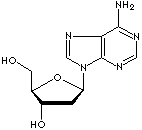PRODUCT IDENTIFICATION
16373-93-6 (Monohydrate)

213-488-7
H.S. CODE
TOXICITY
CLASSIFICATION
PHYSICAL AND CHEMICAL PROPERTIES
soluble
(soluble in caustic soda)
AUTOIGNITION
NFPA RATINGS
REFRACTIVE INDEX
GENERAL DESCRIPTION AND APPLICATIONS
Adenosine
: a purine nucleoside composed of adenine linked by its N9
nitrogen to the C1 carbon of ribose. It is a component of ribonucleic acid and
its nucleotides (AMP., ADP, ATP, cAMP) play important roles in biochemical
processes such as synthesis of nucleic acids and proteins, photosynthesis,
muscle contraction and intracellular signal transduction (cAMP). AMP., ADP, ATP
are three interconvertible compounds in which adenosine is attached through its
ribose group to one (monophosphate), two (diphosphate), and three (triphosphate)
phosphoric acid molecules.
Adenosine Triphosphate (ATP) : a nucleotide composed of adenine, the sugar ribose, and three phosphate groups; involved in energy metabolism and required for RNA synthesis. It exists in cells in a form of high-energy phosphate bond to store and transport chemical energy. The pyrophosphate nature of the bonds between ATP's three phosphate radicals results in a powerful donor of phosphate groups to suitable acceptors. When it is broken down by hydrolysis, it yields ADP (adenosine diphosphate), inorganic phosphorus, and energy. The free energy derived from hydrolysis of ATP is used to drive metabolic reactions including the synthesis of nucleic acids and proteins, to move molecules against concentration gradients (active transport), and to produce mechanical motion (contraction of microfibrils and microtubules). ADP can be further broken down to yield adenosine monophosphate (AMP), additional phosphorus, and more energy. When the phosphorus and energy are immediately used to drive other reactions, such as the synthesis of UDP (uridine diphosphate), an RNA precursor, from UMP (uridine monophosphate), the pair of reactions are said to be coupled. New ATP is produced from AMP using the energy released from the breakdown of fuel molecules, such as fat and glucose which is broken down into pyruvate in the cytosol. Two molecules of ATP are generated for each molecule of glucose. ADT can be converted back to ATP by the processes of oxidative phosphorylation and substrate-level phosphorylation.
Adenosine Diphosphate (ADP) : a nucleotide composed of pyrophosphate of adenosine, involved in energy metabolism; it is produced by hydrolysis of ATP and converted back to ATP by the processes of oxidative phosphorylation and substrate-level phosphorylation.
Adenosine Monophosphate (AMP, also called adenylic acid.) : a nucleotide, 5'-phosphate of adenosine, produced by the hydrolysis of ATP and converted to ADP by adenylate kinase. Involved in the reactions of intracellular energy transfers.
Cyclic Adenosine Monophosphate (cAMP)
: cyclic AMP containing an
additional ester linkage between the phosphate and ribose units; serves as an
intracellular and, in some cases, extracellular secondary messenger mediating
the action of many peptide or amine hormones. It also plays a role in the
transcription of some genes.
Deoxyadenosine (dA) : a purine nucleoside composed of adenine linked by its N9 nitrogen to the C1 carbon of deoxyribose. (deoxy-, also called desoxy, is a prefix for the designation of compounds which contain one less atom of oxygen than the reference substance).
Deoxyadenosine diphosphate (dADP) : a nucleotide, 5'-pyrophosphate of deoxyadenosine.
Deoxyadenosine monophosphate (dAMP) : a nucleotide, 5¢-phosphate of deoxyadenosine, occurring in deoxyribonucleic acid.
Deoxyadenosine triphosphate (dATP): a nucleotide, the 5'-triphosphate of deoxyadenosine; activated precursor in DNA synthesis.
APPEARANCE
98.0 - 102.0%
OPTICAL ROTATION
-24° ~ -26° (c=0.5 in water)
5.0 - 7.5 %
Price: